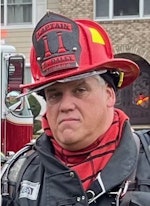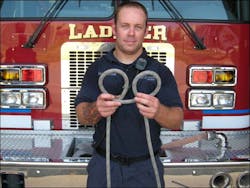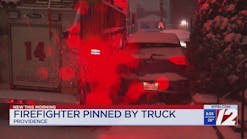From early in our fire service careers, we are taught that there are three priorities on any incident: life safety, incident stabilization, and property conservation. Paramount in this list is life safety, especially the lives of our firefighters.
However, during the discharge of our duties, it is possible that firefighters can become disoriented and trapped, requiring the assistance of a well-trained rapid intervention team; the team on scene that is solely used for the purpose of rescuing trapped or missing firefighters.
But, just how well-trained are our firefighters in the field of rapid intervention and self-rescue? Most departments are aware of the requirements of NFPA 1500 and OSHA as it pertains to rapid intervention teams, but what are we doing to train them to be proficient in their duties?
Simply put, the proper way to successfully train our fire service members in rapid intervention and self-rescue is to teach them early in their careers to not get into a compromising position from the onset. It is imperative that the fire service takes a hard look at this issue, and develop new curriculum for the betterment of our members.
Primarily, firefighters should be trained to identify some of the main reasons why firefighters become trapped, including:
- Failure to identify fire growth and intensity signs. Smoke can provide many clues to the fire's intensity, based on color and density. Also, being able to determine the stage of the fire's growth can help prepare for potential backdraft or flashover conditions.
- Failure to identify building construction characteristics and collapse indicators. Depending on the type of construction, some have specific hazards that can lead to disaster during prolonged interior operations. Also, newer construction techniques and materials can lead to earlier collapses and tightly sealed buildings, allowing the fire to burn unnoticed for longer periods of time.
- Failure to identify the signs of flashover. All too often, firefighters fail to recognize some obvious signs of flashover. Our members are taught to look, listen and feel for flashover:
- Look for the presence of rollover or flameover
- Listen for crackling of the fire, any hoselines that should be in operation, and any ventilation operations that could alleviate the buildup of heat; and
- Feel for any sudden increase of temperature in your location, and if there is, leave the area immediately.
- Failure to recognize that an activating PASS device is considered an emergency! From early stages of firefighter training, candidates develop the habit of keeping their PASS devices from activating while they are rotating through skills sessions during their time spent at the academy. Unfortunately, this practice leads to complacency on the part of the firefighter when an active PASS device is sounding. Many times newer firefighters on the scene of an emergency tend to ignore this signal of distress. This can have disastrous results, therefore it is imperative to train firefighters that any PASS device activation is to be considered an emergency until proven otherwise.
- Failure to communicate the emergency. What does a firefighter do when transmitting a Mayday? There are a few things that should be included in the message, using the acronym LUNAR:
Location information is vitalThe best descriptive location that you can supply the incident commander is going to save a lot of time during the process of finding your crew.
Unit designation. Knowing what crew went missing may aid in finding them. Knowing who was given a specific assignment may narrow down their location of what area of the structure that they were working in.
Name of the person calling the Mayday.
Assignment in process. The task given to the crew may suggest that their situation is dire. For example, a crew that was stretching an attack line into the seat of the fire that got cut off by a collapse or fire spread is in need of urgent rescue.
Resources available to the crew. Knowing what tools and equipment that is available to the crew may aid them in self-rescue and can greatly improve their chances of survival.
Along with the information listed above, it is important that firefighters are taught practical skills for their participation as RIT team members, and some self-rescue skills they can employ should they get caught in a hostile environment.
Self-Rescue Skills Training Examples
From a window: In the event egress is required out of a window, remove the entire window assembly; not too many firefighters can fit through a double-hung window in full gear with an SCBA on their back. If the firefighter is on a lower floor, they can hang-drop to safety. If they are on an elevated floor, wait at the window and call for a ladder if time will allow. Once the ladder is in place, all team members shall exit the structure. If emergency egress is necessary due to rapidly deteriorating conditions in the room, the ladder can be placed at a 45-degree angle, instead of the normal 75-degree angle, to allow for a safer slide down the ladder. Then, the firefighter slides head first onto the ladder until their ankles catch the windowsill or the first rung of the ladder (see Photo 1.) Once in place, the firefighter can spin around and then climb down the ladder in the normal position (see Photo 2.) Once all team members have exited, the crew notifies the incident commander that all members are accounted for and safe.
Should a ladder prove to not be feasible, firefighters may incorporate an emergency rappel. Since many departments use many different types of descent devices today, firefighters should have a thorough background in rope rescue, rappelling and descent device usage prior to attempting this skill in a hostile environment. Firefighters should be equipped with, at a minimum, a Class II Harness, 50 feet of personal escape rope, some sort of descent device, and carabiners for attachment purposes. The firefighter should first set a barrier between them and the fire, such as closing a door to the room they are in. After securing a reliable anchor point, the firefighter keeps tension on the rope and makes their way out the window, descending the rope until they are on the ground. Due to the deteriorating conditions in the structure, the firefighter should be on the ground safely after the descent in no more than 30 seconds.
Breaching a wall: It may become necessary for a firefighter to breach through a wall to get to an uninvolved area of the structure, or to an area outside of the structure. Prior to breaching the wall, the firefighter should notify command of their location, so that a handline can be sent to their location to assist in egress. Most walls will have wall studs that are 16 inches on center, and are covered with sheetrock. Crews can remove the sheetrock on both sides of the wall, and manipulate their way through the studs using a reduced profile maneuver (see Photo 3): the firefighter loosens the shoulder straps on their SCBA and removes the strap that does not have the air line to the SCBA mask on it. The SCBA waist strap is loosened, and the SCBA is rotated under the arm of the firefighter. With the SCBA tucked into position, the firefighter can then pass through the wall studs after checking the floor condition on the other side of the wall.
Follow the hoseline: In the event a firefighter becomes disoriented, they can find a hoseline and use it to guide their way out (see Photo 4). Depending on the direction of travel, the firefighter will find either the nozzle on the end of the hose, or find the egress out of the structure. Some departments use hose that have arrows painted onto their hoses, with arrows pointing to the way out of the structure. At a minimum, when the firefighter comes across the coupling, the female end of the coupling will face in the direction of the exit.
Rapid Intervention Team Skills
Firefighter fallen through the floor: The best and quickest access to the downed firefighter might be through the hole in the floor, depending on the severity of the collapse. The RIT team may have to work around remaining floor joists that are still in the hole. If that is the case, a ladder should be placed in between the remaining joists (see Photo 5.) A hoseline should also be deployed to this location to provide protection for the downed firefighter, and the rescuers that are entering the hole to retrieve them.
Once the RIT members have located the downed firefighter, a rope can be lowered to the rescuers and a handcuff knot can be attached to the victim at the wrists (see Photos 6A - 6G.) If the knot is tied in the center of the rope, then two members of the RIT team can assist in lifting the victim out of the hole in the floor (see Photo 7.)
Moving a firefighter up and down a flight of stairs: Trying to grip wet firefighting gear can be very difficult, especially during an emergency. Therefore, it would be beneficial to utilize the SCBA harness to lift and move the firefighter. First, the SCBA waist strap should be repositioned so the waist strap runs between the legs of the downed firefighter (see Photo 8.) Then, the rescuer at the head of the victim can utilize the SCBA shoulder straps to lift and move the firefighter. The second firefighter can position at the knees of the victim, and the team can move the victim safely up or down a flight of stairs Photo 9.)
Moving a firefighter out a window: This will require a minimum of four rescuers, with two rescuers inside with the victim and two of the rescuers positioned outside the window on two ladders, standing by with a litter to receive the victim. One rescuer is positioned inside between the victim and the window, with their back up against the wall, under the window. The second interior rescuer is positioned on the opposite side of the victim. The rescuer at the wall acts as a ramp and lifts the victim straight up, while the second rescuer pushes the victim toward the window, into the litter that the two outside rescuers are standing by with (see Photos 10 abd 11.) The outside team members can assist in placing the victim into the litter. Once the victim is in the litter, the two rescuers carry the litter directly to waiting EMS personnel for treatment and transport.
In Conclusion
It is the responsibility of every member of the fire service to provide for their own health and safety, including being able to identify the signs of deteriorating conditions during interior operations. Self-rescue skills should be second nature to all firefighters; the time to practice these skills is before the emergency, under both normal and compromised environments inside the building. These skills, along with sound rapid intervention team practices, will go a long way to ensure the safety of all members operating on the fireground.
MICHAEL DALEY is a lieutenant and training officer with the Monroe Township, NJ, Fire District No. 3, and is an instructor with the Middlesex County Fire Academy, where he is responsible for rescue training cirriculum development. Mike has an extensive background in fire service operations and holds degrees in business management and public safety administration. Mike serves as a rescue officer with the New Jersey Urban Search and Rescue Task Force 1 and is a managing member for Fire Service Performance Concepts, a consultant group that provides assistance and support to fire departments with their training programs and course development. You can reach Michael by e-mail at [email protected].

Michael Daley
MICHAEL DALEY, who is a Firehouse contributing editor, is a 37-year veteran who serves as a captain and department training officer in Monroe Township, NJ. He is a staff instructor at multiple New Jersey fire academies and is an adjunct professor in the Fire Science Program at Middlesex County College. Daley is a nationally known instructor who has presented at multiple conferences, including Firehouse Expo and Firehouse World. His education includes accreditations as a Chief Training Officer and a Fire Investigator, and he completed the Craftsman Level of education with Project Kill the Flashover. Daley is a member of the Institution of Fire Engineers and a FEMA Instructor and Rescue Officer with NJ Urban Search and Rescue Task Force 1. He operates Fire Service Performance Concepts, which is a training and research firm that delivers and develops training courses in many fire service competencies.






